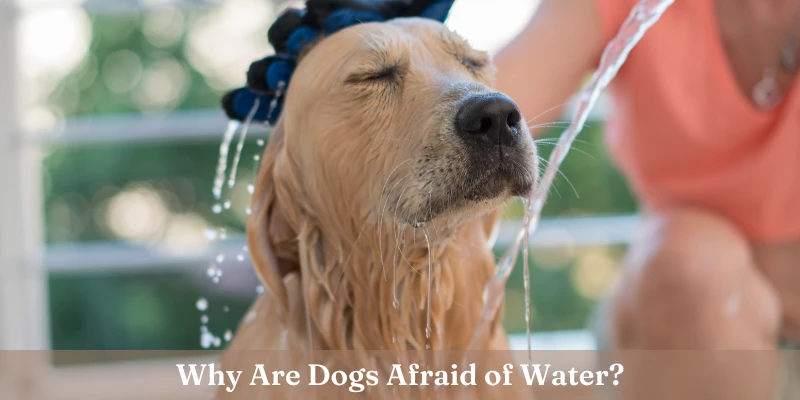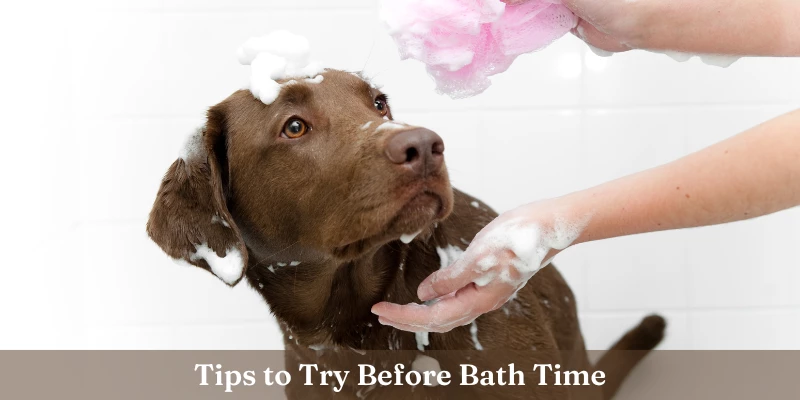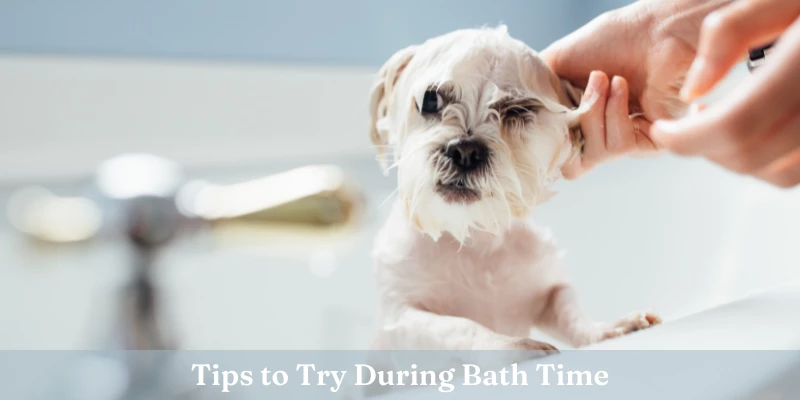If you have a dog that is afraid of water and scared to take a bath, then you understand how frustrating and time-consuming it can be to bathe your dog.
I have 2 dogs that are scared of getting in the water and afraid to take a bath, so I’ve had to try just about everything you can think of to make bath time easier for them and me.
Luckily for me, I’ve found some things that work after trying many things that didn’t.
I’m going to share what works for me and my dogs during bath time in hopes that you can follow some of these simple tips to help make bathing your dog become a pleasant experience for you and your pet.
Why are Dogs Afraid of Water?
Some dogs are just naturally afraid of water, but that’s not the case for all dogs. Some dogs actually love water.
My friend has a dog that runs and jumps into the pond head-first every time we go to a specific park.
More often than not though, “Why are dogs afraid of water?” is the wrong question to be asking.

The right question to be asking is “Why is my dog scared to take a bath?“.
It isn’t so much that dogs are afraid of water as it is about them being comfortable with the water and the actual environment where their bath is being conducted.
Check out 7 tips below that have helped me in preparing to bathe my dogs in the bathtub.
7 Tips to Try Before You Bathe a Scared Dog
If your dog is scared of water and afraid to take a bath like my dogs are, try some of these tips before bath time to help your dog be more comfortable around water.

1. Do Trial Runs
Do some trial runs where you bring your dog into the bathroom, turn the water on in the tub and provide her with treats while the water runs.
This will help her associate the bathroom and the running water with a positive experience since she is getting treats.
2. Be Around Water
Take your dog to the beach or around a river or lake. If you take her walking, try to find a park or walking trail that includes a body of water.
Having her around water often can help get her more comfortable for bath time.
3. Pat Her Down
Ease your dog into bath time by using a wet cloth to pat her down. Give her a treat or two while you do this to help her associate being wet with a positive experience.
4. Don’t Use the Umbrella
If you are walking your dog outside and it starts to rain, don’t try to run for cover or open the umbrella. Let her get wet.
The more often she gets wet, the less anxious she will be around water.
5. Do Use the Sprinklers
If you have sprinklers, play with your dog outside in the yard while having the sprinklers on.
The goal is to find as many ways to have her around water as possible to get her to a point where she is more comfortable.
Once she becomes more comfortable being around water, she should start to be more comfortable when you bathe her.
6. Play in The Puddles
Take your dog for a walk after it has stopped raining. Let her play in the puddles or the streams of water as you walk her.
I know you see the pattern by now, which is to get her more comfortable around water.
7. Prep the Tub
You won’t find many dogs that like loud noises. While the water running may not be an issue for you, dogs are more sensitive and can become anxious because of the loud noise coming from the running faucet or shower head.
Try having the water already in the tub before you bring your dog into the bath to cut down on noise.
20 Tips to Try While Bathing a Scared Dog
Do you have a dog that’s afraid of water or scared to take a bath? Are you not sure how to bathe them or just need help easing the pain of bath time?
Check out these 20 helpful tips that will help your dog be at ease while bathing in the bathtub.

1. Make Things Comfy
Create a comfortable environment for your dog. Bring her favorite toy with her to bath time.
Not all dogs are the same, but you should be aware of what makes your dog comfortable, so just try that.
2. Be Firm with Love
Be firm with your dog during bath time but never yell or get angry with her. She will sense the emotions and it will just make the situation worse.
Be in control but not in a way that is going to make her uneasy or scared even more.
3. Use a Non-Slip Mat
If you are bathing your dog in the bathtub, try using a non-slip mat so it is easier for her to maintain traction and not slip around the tub.
This will help ease her nerves and ensure you aren’t trying to hold her still while she is slipping all over the tub.
If you don’t have a mat handy, you can substitute the mat with a folded towel or something similar.
4. Give Soft Pats and Rubs
Once you’ve gotten your dog in the tub, reassure her that everything will be okay by giving her soft pats and rubs on her head and back.
Speak softly and offer treats to help her associate bath time with something positive for her good behavior while getting her bath.
5. Don’t Rush Things
If your dog is really nervous about taking a bath, do light practice sessions first where you just put her in the tub with a little water and help her associate it with positive experiences.
Give her lots of affection, and provide her with treats while in the tub. Tell her how good of a job she did after you get her out of the bathtub.
In time, you will start seeing her get less anxious about being bathed.
6. No Loud Noises
Never make any loud noises or have high water pressure. This can startle your dog and cause her to become more anxious and scared while taking a bath.
7. Keep Water Pressure Low
Ensure your shower head isn’t noisy and that it is in a setting that won’t make your dog uncomfortable.
The water stream shouldn’t be on a high level or have hard pressure because this will cause her discomfort as well.
8. Control Water Flow
If you aren’t using a shower head and just the faucet, keep the water pressure low and use a bowl, cup, or another container to pour the water over your dog so you can control the flow of water and where it is being poured.
By using a container to pour over her, you cut the noise of the faucet out, which will help ease her nerves if she doesn’t like loud sounds like my dogs.
9. Remove Startling Objects
Remove anything around the bathtub that could fall and startle your dog.
The last thing you want in the tub with a wet dog is for her to get startled and try to scramble to get away, leaving you with a wet bathroom, hallway, bedroom, and wherever else she escapes.
10. Move the Shampoo Bottle
As for the shampoo bottle itself, just keep it on the floor next to you. If you keep it on the floor next to you and it falls over there, it is less likely to startle your dog.
Keeping it in or on the top of the bathtub may be convenient for you but could startle her if the bottle drops in the water or on the floor.
11. Start from the Bottom Up
When you start to bathe your dog, try to start wetting her from the bottom up. Start with her paws and legs and move up to her belly and so on.
Just pouring the water over her without giving her an opportunity to get comfortable with the water touching her may make her more uneasy and we don’t want that.
12. Speak Softly with Affection
If she is doing a good job and not moving around, remember to reward her and let her know by giving her treats and soft pats – and speaking to her in an affectionate, positive-sounding voice.
13. Massage the Shampoo In
Once you’ve gotten your dog all wet, start to lather her with a dog shampoo (not human). To get the most out of your shampoo and to ensure she is cleaned properly, massage the shampoo in for about 5 minutes.
I would suggest leaving her head and face as the last things to wash since these will likely be the parts that make her more uneasy than others.
14. Turn the Water Off
During the lathering stage, it is up to you whether you leave the water running or not.
I just turn my water off after getting enough in the tub because the sound of running water can cause anxiety in some dogs, including mine.
Having the water off seems to help my dogs stay at ease.
15. Repeat the Process
If your dog has been rolling around in the mud, you may want to lather her up again after the initial lather and repeat the process.
However, if she is very afraid of the water, then one lather should do as long as the soap is massaged in really well and enough time is given to break up the grit and grime in her fur.
16. Rinse Thoroughly
Rinse your dog thoroughly. You can repeat the steps in the order of how you first got her wet, starting at the bottom and moving up.
17. Choose a Dry Method
How you dry your dog is up to you. Some will tolerate a blow dryer but a towel works best with my dogs.
If you are going to use a blow dryer, just remember that it may get very hot and is loud, things she may not be able to tolerate.
So, be careful if you are going to use a blow dryer.
18. Dry Thoroughly
When drying her, ensure you remove as much of the moisture as you can to cut down on the chance of any health issues.
19. No Air Drying
Air drying is never recommended because it will leave moisture that can cause fungus, matting, and even more serious issues like ear infections.
20. Don’t Forget Many Treats
Once the process is complete, don’t forget to give her a treat and let her know how excellent of a job she did in the bath.
Once the bath is over, follow it up by doing something your dog loves to do. After all, she has earned it by being such a good doggy.
If you follow these tips, hopefully, your dog will become less afraid and won’t be trying to escape during bath time.
This will make your life easier and you won’t have to work as hard to get your dog to stay for her bath.
Recap
In this article, I discussed many different tips to try and help you when bathing your dog.
Bath time can be scary for dogs but it doesn’t have to be.
If only one of these tips works to help you bathe your dog with less headache, then I’ve done my job.
If two or more of these tips work, then you owe me breakfast. 🙂
I hope your dog can enjoy her bath as much as mine are starting to after implementing some of the tips above.
If you enjoyed this article, check out other dog articles I’ve written.





